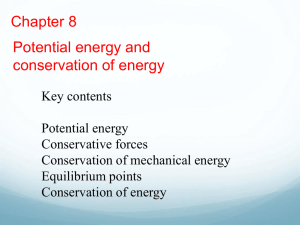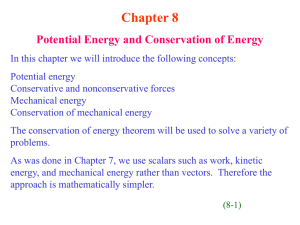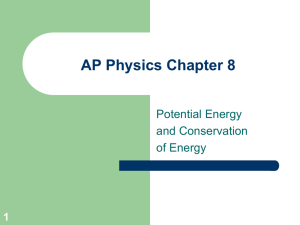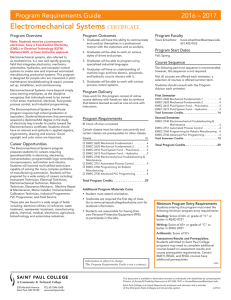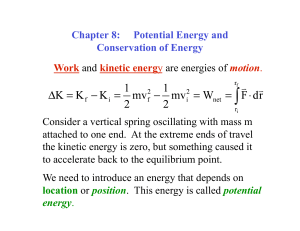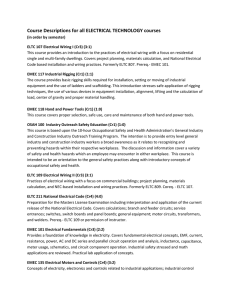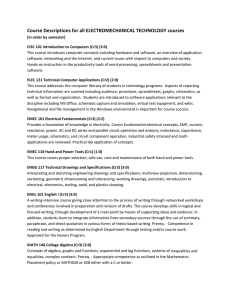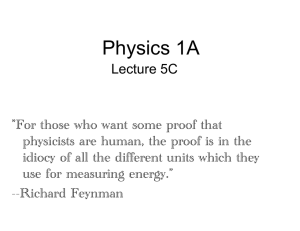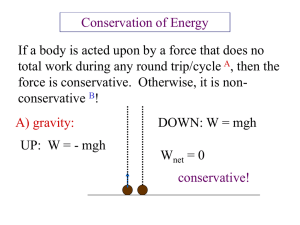Chapter 8
advertisement
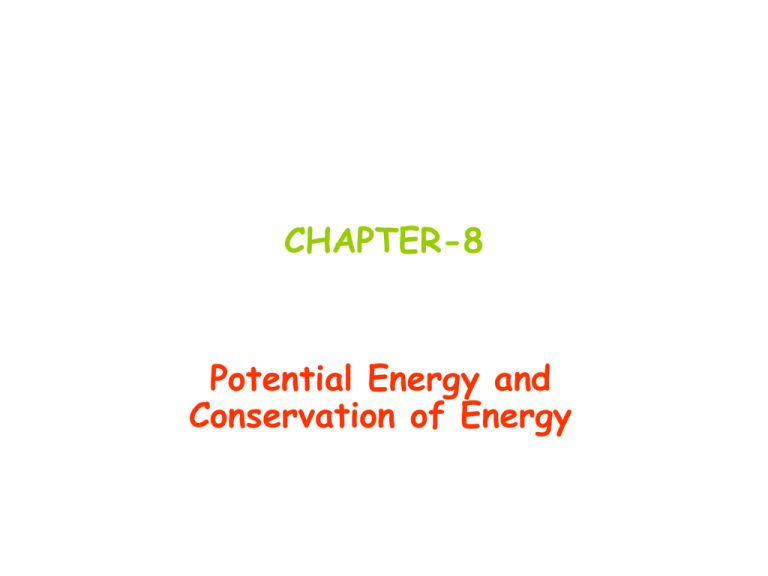
CHAPTER-8 Potential Energy and Conservation of Energy 8-1 Potential Energy Potential Energy U: energy associated with the configuration of a system of objects that exerts force on one another. Gravitational Potential Energy Ug: energy associated with the separation between two objects that attracts each other by gravitational force. Elastic Potential Energy Us: energy associated with the compression or extension of an elastic object. Ch 8-2 Work and Potential Energy Kinetic (K) and Gravitational Potential energy (Ug) of tomatoearth system Negative work Wg done by gravitational force in the rise of tomato in transferring K (decreasing) into Ug (increasing) of tomato Positive work Wg done by gravitational force in the fall of tomato in transferring Ug (decreasing) into K (increasing) of tomato. Ug =- Wg or - Ug = Wg Ch 8-2 Work and Potential Energy Kinetic (K) and Elastic Potential energy (Us ) of block-spring system Negative work Ws done by spring force in the rightward motion transferring K (decreasing) of block into Us (increasing) of spring Positive work Ws done by spring force in the leftward motion transferring Us (decreasing) of spring into K (increasing) of block. Us =- Ws or - Us = Ws Ch 8-2 Conservative and Nonconservative Forces System contains two or more objects including a point-like objects (tomato or block) A force acts between point-like object and rest of the system When the configuration change force does work W1, changing kinetic energy K of the object and other type of energy of the system When the configuration change reversed, force reverse the energy transfer and does work W2 Conservative Force: W1=-W2 Nonconservative Force: W1-W2 Ch 8-3 Path Independence of Conservative Forces The net work done by a conservative force on a particle moving around any closed path is zero. U=-W=0 Ui=Uf (cylic process) The work done by a conservative force on a paticle moving between two points does not depends on the path Wab1=Wab Ch 8 Check Point 1 • The figure below show three paths connecting points a and b. A single force F does the indicated work on a particle moving along each path in the he indicated direction. On the basis of this information is the force conservative? • Non-conservative force Ch 8-4: Determining Potential Energy Values Work done by a conservative force F xf W=xi F (x) dx but U =-xfW , then U =- W =- xi F (x) dx Gravitational Potential Energy Ug: yf Ug=-yi -mg dy= mg(yf-yi); Ug(y)= mgy Elastic Potential Energy Us: yf US=-yi -kx dx= k(xf2-xi2)/2; Us(y)=(kx2)/2 Ch 8 Check Point 2 •A particle to move along an xaxis from x=0 to x=x1., while a conservative force , directed along the x-axis, acts on the particle. The figure shows three situations , in which the x component of that force varies with x. The force has same maximum magnitude F1 in all three situations. Rank the the situation according to the change in the associated potential energy during the particle motion , most positive first U= -Fxdx Calculate area under the curve 1) U=-(Fi X1)/2 2) U=-(Fi X1) 3) U=-[-(Fi X1)/2]= FiX1/2 Ans: 3, 1, 2 Ch 8-5: Conservation of Mechanical Energy Mechanical energy Emec: Emec=K+U In an isolated system where only conservatives forces cause energy change Emec is conserved K=W; U =-W then K=-U Kf-Ki=-(Uf-Ui)=Ui –Uf Kf+Uf =Ki+Ui Emec-f = Emec-i Emec=0 Ch 8-7: Work Done on a System by an External force Work Wa is energy transfer to or from a system by means of an external force acting on that system Work done on a system , no friction involved (Ball –Earth system) Wa=K+U= Emec Ch 8-7: Work done on a system by an external force Work done on a system , friction involved (Block–floor system) F-fk=ma; v2=v02+2ad; a=(v2-v02)/2d F=fk+ma= fk+m(v2-v02)/2d Wa =Fd=fkd+m(v2-v02)/2 Wa =fkd +K= Eth + Emec Eth=fkd Wa=K+U= Emec Ch 8-8 Conservation of Energy Total energy E= Emec+Eth+Eint The total energy E of a system can change only by amounts of energy W that are transferred to or from the system W=E= Emec+ Eth+ Eint , W is work done on the system. Isolated System: The total energy E of an isolated system cannot be changed then E= Emec+ Eth+ Eint=0 Emec-f-Emec-i + Eth+ Eint=0 Emec-f= Emec-i - Eth- Eint
